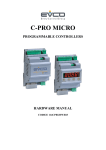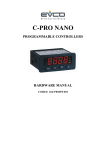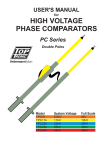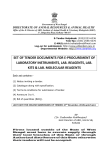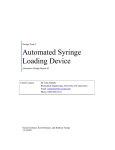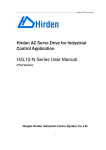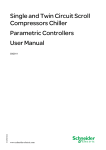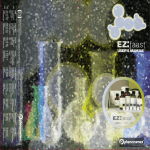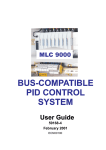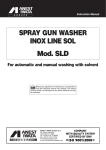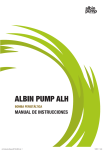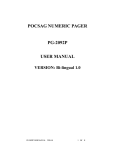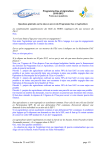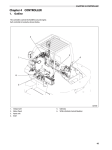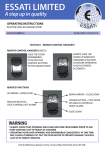Download TM168DEVCM User Manual
Transcript
DRIVER FOR ELECTRONIC EXPANSION VALVES TM168DEVCM USER MANUAL TM168DEVCM USER MANUAL Summary 1 GENERALITIES .......................................................................................................................3 2 TECHNICAL FEATURES .......................................................................................................4 2.1 2.2 2.3 2.4 2.5 2.6 3 CONNECTIONS .......................................................................................................................4 TM168DEVCM ELECTRIC CONNECTION ..............................................................................5 TM168DEVCM DIMENSIONS AND INSTALLATION ...............................................................6 GENERAL FEATURES .............................................................................................................9 TECHNICAL FEATURES ..........................................................................................................9 ELECTRIC FEATURES ...........................................................................................................10 USER INTERFACE ................................................................................................................11 3.1 3.2 3.3 3.4 3.5 3.6 3.7 3.8 DISPLAY AND KEYBOARD ....................................................................................................11 MAIN PAGE .........................................................................................................................13 TEMPORARY DISPLAY OF THE QUANTITIES ..........................................................................13 SETTING THE WORK SET-POINT ...........................................................................................13 SETTING THE CONFIGURATION PARAMETERS ......................................................................13 RESTORE THE DEFAULT VALUE OF THE CONFIGURATION PARAMETERS ...............................14 MAIN MENU ........................................................................................................................14 DISPLAY OF FIRMWARE IDENTIFICATION .............................................................................14 4 LIST OF PARAMETERS .......................................................................................................15 5 FUNCTIONING.......................................................................................................................19 5.1 5.2 5.3 5.4 5.5 6 DIAGNOSTICS........................................................................................................................22 6.1 6.2 6.3 7 PRELIMINARY CONSIDERATIONS .........................................................................................19 ENABLING MODE FOR VALVE REGULATION .........................................................................19 MANUAL FUNCTIONING MODE ............................................................................................19 VALVE STATE ......................................................................................................................21 FUNCTIONING MODE (SELECTION FROM THE PARAMETERS SET)..........................................21 PROBE ALARMS ...................................................................................................................22 ALARM RELAY ....................................................................................................................22 ALARMS TABLE ...................................................................................................................22 LIST OF THE MODBUS VARIABLES................................................................................23 7.1 7.2 7.3 7.4 7.5 INTRODUCTION ...................................................................................................................23 ADDRESSING CONVENTIONS ................................................................................................23 IMPLEMENTED MODBUS FUNCTION CODES .........................................................................23 DATA EXCHANGE EXAMPLES...............................................................................................24 HOLDING REGISTER ADRESSES TABLE .................................................................................25 Page 2 TM168DEVCM USER MANUAL 1 Generalities TM168DEVCM is a stand-alone driver for electronic expansion valves. The instrument has: • 1 measurement input for pressure transducers 4-20 mA (evaporation probe) • 1 measurement input for NTC probes (intake probe) • 1 high voltage digital input (functioning consent) • 2 low voltage digital inputs (functioning consent and state of the back-up battery charge) • 1 power supply input coming from the back-up battery • 1 digital output (relay), 5 A resistif. @ 250 VDC, for alarm output control • 1 serial port with MODBUS communication protocol • The device can function only with the Alco Control valves belonging to the EXM, EXL, EX4, EX5, EX6, EX7, EX8 and EX9 ranges. The device is in 4 modules DIN module. The user interface is made up from a custom display with 4 digits (with function icons) and 4 keys (set, up, down and escape). Among the many features, the following are also indicated: • front panel protection rating IP54 • management of high over-heating and low over-heating alarms • MOP function (Maximum Operating Pressure) • LOP function (Lowest Operating Pressure). Page 3 TM168DEVCM USER MANUAL 2 Technical features 2.1 Connections Power supply: TM168DEVCM is powered by an alternating current equal to 24 V. The maximum length of the power supply connection cables is 1 m. The TM168DEVCM power supply is not isolated; therefore it must be galvanically isolated from other devices. Connection of the analogue inputs: TM168DEVCM has two analogue inputs, one for NTC temperature probe and one for pressure transducer 4-20 mA. The pressure transducer can be powered via a 12 VDC unstabilised voltage, available on an instrument clamp. The maximum length of the analogue input connection cables is 3 m. Connection of the digital inputs: TM168DEVCM has three digital inputs of which two low voltage (functioning consent and back-up battery charge state) non optoisolated and one in high voltage (functioning consent). The maximum length of the digital input connection cables is 3 m. Connection of the digital outputs: TM168DEVCM has one digital output with electro-mechanical relay. The maximum length of the output connection cables is 10 m. Connection of the electronic expansion valve: The maximum length of the electronic expansion valve connection cables is 6 m. Precautions The indications regarding the maximum lengths of the connections imply that a series of precautions are respected. To prevent immunity problems, it is good practice to comply with the following indications: avoid places with antennas do not wire probe inputs with relay outputs; generally, prevent mixing low and high voltage signals do no wind cables around power components Page 4 TM168DEVCM USER MANUAL 2.2 TM168DEVCM electric connection Below find the TM168DEVCM connection layout with relative table regarding the meaning of inputs and outputs. Connector 1: functioning consent relay output and digital input (high voltage). Code Description NO1 K1 relay normally open contact CO1 K1 common relay COHV Functioning consent digital input (230 VDC ± 15%) COHV Functioning consent digital input (230 VDC ± 15%) Connector 2: electronic expansion valve. Code (Alco reference) Description for EXM-246 / EXL-246 (1)valves V1 Shield V2 (2B) White wire V3 (2A) Orange wire V4 (1B) Blue wire V5 (1A) Yellow wire Code (Alco reference) Description for EX4 / EX5 / EX6 / EX7 / EX8 / EX9 valves V1 Shield V2 (2B) White wire V3 (2A) Black wire Page 5 TM168DEVCM USER MANUAL (1) V4 (1B) Blue wire V5 (1A) Brown wire The red wire and the brown wire are not used. Connector 4: instrument power supply, back-up battery power supply, measurement inputs, digital inputs. Code Description 1 Instrument power supply (24 VDC) 2 Common analogue and digital inputs 3 Common analogue and digital inputs 4 Common analogue and digital inputs 5 Not used 6 Not used 7 Analogue input 2 (NTC temperature probe) 8 Analogue input 1 (pressure transducer 4-20 mA) 9 Instrument power supply (24 VDC) 10 Back-up battery power supply (12 VDC) 11 Pressure transducer power supply (12 VDC) 12 Not used 13 Not used 14 Not used 15 Functioning consent digital input 16 Back-up battery charge state digital input Connector 5: to the TTL / RS-485 interface. 2.3 TM168DEVCM dimensions and installation The mechanical dimensions of TM168DEVCM are given below; the measurements are expressed in mm (in). Installation recommendations: make sure that the work conditions (temperature of use, humidity, etc.) lie within the limits indicated in the technical data Page 6 TM168DEVCM USER MANUAL - - do not install the instrument in proximity of heat sources (resistances, hot air pipes etc.) appliances with strong magnets (large diffusers etc.), places subject to direct sunlight, rain, humidity, excessive dust, mechanical vibrations or shocks in compliance with Safety Standards, the protection against any contact with the electric parts must be ensured via correct installation of the instrument. All parts that ensure protection must be fixed in a way such that they cannot be removed without the aid of a tool Page 7 TM168DEVCM USER MANUAL To install TM168DEVCM, operate as indicated in the diagrams (points 1 and 2). To remove TM168DEVCM, use a screwdriver and operate as indicated in the diagrams (points 3 and 4). Page 8 TM168DEVCM USER MANUAL 2.4 General features Reference Standards regarding safety Purpose of the device Storage conditions Functioning conditions Class according to the protection against electric shocks Type of disconnection PTI of the insulating materials Container Type of actions Pollution Class of software Period of the electric stress of the insulating parts Front panel protection rating EN60730-1 Electronic expansion valve driver -10T65 °C non-condensing R.H.<80% 0T50 °C non-condensing R.H.<80% Control device to be integrated; assumes the classification of the appliance with which it is integrated Reduced interruption (relay contacts) >=250V Assembly on omega guide 1C Normal A Long IP40 2.5 Technical features Connection for low voltage signals Power connector IntraBus serial port connection Connection for the parameters key, TTL serial output for RS-485 module, interface for Flash programming Mini-Fit 16-way Phoenix disconnectable terminal board Cable section > 0.75mm2 Phoenix disconnectable terminal board 6-way AMP micro-maTch SPECIFICATIONS OF THE 16-WAY MINI-FIT CONNECTOR SUPPLIER CONNECTOR CODE CONTACTS CODE Note: use the appropriate tool for crimping CVILUX SELECOM CP-01 116010 (V2) CP-01 116020 (V0) 6137R16WO (V2) JUSCOM 1090-557-162 (V2) CONEXCON 6740-1161 (V2) 6740-1160 (V0) 39-01-2160 (V2) 39-01-2165 (V0) MOLEX Page 9 CP-01 1000102 (AWG16÷24) 6137TR1 (AWG16÷20) 6137TR2 (AWG22÷26) 1150-156-012 (AWG18÷22) 1150-156-002 (AWG22÷26) 6744-2000 (AWG18÷22) 39-00-0038 (AWG18÷24) 39-00-0046 (AWG22÷28) TM168DEVCM USER MANUAL 2.6 Electric features Power supply Digital outputs Valve motor outputs Digital inputs in low voltage Digital inputs in high voltage Analogue inputs for NTC probes Analogue inputs for pressure transducers Back-up battery power supply input back-up Voltage Range Frequency Maximum power absorbed Protection fuse Number Type Maximum contact current at 250Vdc Number of manoeuvre cycles Minimum interval between switch-overs Type of micro switch interruption action Insulation between the relay and low voltage Number Type Power supply Number Type Current on the closing contact towards earth Maximum closure resistance Detection time from OFF to ON Detection time from ON to OFF Number Type Voltage range Min. detection time from OFF to ON Min. detection time from ON to OFF Number Type NTC measurement range Number Type Current measurement range Power supply Input resistance Voltage Type of battery Battery charger Maximum power absorbed Protection fuse 24 VDC -10% +15% 50/60Hz 30VA External 1 Electro-mechanical relays 3 (1) A 100.000 20s 1C Reinforced 1 Step-by-step motor driver Generated inside the module 2 Potential-free contact 2mA 100Ω 100ms 100ms 1 Optoisolated 230 VDC ± 20 % 100ms 100ms 1 NTC (10 KOhm ± 1 % @ 25 °C) -50°C ÷ 50°C in fluid -50°C ÷ 105°C in air 1 Current 4-20 mA 8 ... 30 VDC < 200 Ohm 12 VDC lead, 12 V, 2 ...6 Ah I max = 150 mA, V max = 13 V 30VA External The high voltage digital output and the digital input have reinforced insulation with respect to the remaining I/O. Page 10 TM168DEVCM USER MANUAL 3 User interface 3.1 Display and keyboard The built-in interface on the controller is made up from a 4 digit custom display (for displaying quantities), 4 keys (for surfing) and 16 icons (for immediate and intuitive representation). Main functions that can be activated using the keys: Key pressed DOWN during lamp test from power-on DOWN for 2 seconds SET/ENTER for 2 seconds DOWN + UP for 4 seconds UP Function Display version/firmware revision Quantity temporary display Display/ over-heating set-point modification (PH30=0 disables the possibility for modification) Display/modify/reset parameters Alarms display Page 11 TM168DEVCM USER MANUAL for 2 seconds ESC for 2 seconds SET/ENTER + DOWN for 2 seconds Display /modify % valve output n manual mode Block/Release keyboard Meaning of the icons: Icon bar Colour Green psi Green Green valve closed % Amber °F Red °C Red Red maintenance Red alarm HP (MOP) Green LP (LOP) Green SH Green SP Green Function Identifies the unit of measurement selected. If on, it indicates that the pressure is expressed in bar Identifies the unit of measurement selected. If on, it indicates that the pressure is expressed in psi Identifies the valve state (closing): Off: the valve is closed or off or <5% On: the valve is open at a value > 95 % Flashing: the valve is working If on, it indicates that the % opening of the valve is being displayed Identifies the unit of measurement selected. If on, it indicates that the temperature is expressed in °F-°R Identifies the unit of measurement selected. If on, it indicates that the temperature is expressed in °C-°K Identifies the request for maintenance. If on, the valve is operating in manual mode. Identifies the presence or not of alarms. Alarms are present if it is on, otherwise it remains off. It is active when the MOP function is activated Off: function not active On: MOP function enabled Flashing: MOP alarm It is active when the LOP function is activated Off: function not active On: Low pressure alarm Flashing: LOP alarm It is active when the SH function is activated Off: function not active On: function on (I am viewing the SH value) Flashing: LSH, HSH alarm Identifies that a set-point is being displayed. Flashing: the set-point is being modified. Page 12 TM168DEVCM USER MANUAL Green Battery state (DI2) Off: Battery charged On: Back-up battery being charged or back-up module disconnected Identifies the state of the valve Off: valve on (enabled) On: valve off (disabled) Flashing: valve in start-up Identifies the Intrabus communication state Off: No communication On: Communication error Flashing: Communication OK Back-up battery Red on/stand-by central decimal point higher Red 3.2 Main page The main screen changes according to the state of the valve: if the valve is not enabled (vale open and regulation deactivated) OFF is shown and the relative icon (stand-by) is on; if the valve is enabled (valve closed and regulation activated) the values selected by the PdIS parameter is selected (or an error label). The relative icon (stand-by) is off (an icon corresponds to the quantity displayed). 3.3 Temporary display of the quantities Operate as indicated: press the DOWN key for 2 seconds: the SH label is displayed press the SET/ENTER key to display the over-heating value measured press the UP or DOWN key to change the default display according to the following table: SH PrES PErC TEMP TSAT SHSP SEtP Over-heating value measured Pressure value measured % valve opening Temperature value measured Temperature value calculated (from the pressure) Over-heating set-point value Set of parameters currently selected To exit the procedure: press SET or do not operate for 60 seconds or press UP or DOWN until the display shows the quantity established by the PdIS parameter or press the ESC key. 3.4 Setting the work set-point Operate as indicated: make sure that the machine is on, that the keyboard is not blocked and that no procedure is in progress press the SET/ENTER key for 1 s: the display will show the current over-heating set-point press the UP or DOWN key within 15 s press SET/ENTER or do not operate for 15 s. Using parameter PH30 it will be possible to block the possibility of modifying the set point; in his case, if you try to modify the set-point, LOC is shown for 2 s. 3.5 Setting the configuration parameters This paragraph presents the menus found in the application. The main menu is divided into two levels (user and installer). The installer level is protected by a password. The range of values for those that can be set for the password is -99 / 999 (default = –19). After 1 minute that no key is pressed, the password expires and must be set again. To access the procedure, operate as indicated: make sure no procedure is in progress Page 13 TM168DEVCM USER MANUAL press the UP and DOWN key for 4 s the display will show a label. To select a parameter: press the UP or DOWN key. To modify a parameter: press the SET/ENTER key press the UP or DOWN key within 15 s press the SET/ENTER key or do not operate for 15 s. To access the installer level: press the UP or DOWN key to select PA. press the SET/ENTER key press the UP key or the DOWN key within 15 s to set the password defined with the “PASS” parameter (default -19) press the SET/ENTER key or do not operate for 15 s press the UP and DOWN key for 4 s the display will show a label. To exit the procedure: press the UP and DOWN key for 4 s or do not operate for 60 s. Cut off the power supply to the instrument after modification of the parameters. 3.6 Restore the default value of the configuration parameters Operate as indicated: make sure no procedure is in progress press the UP and DOWN key for 4 s the display will show a label press the UP or DOWN key to select PA press the SET/ENTER key press the UP or DOWN key within 15 s to set 743 press the SET/ENTER key or do not operate for 15 s press the UP and DOWN key for 4 s the display will show dEF. press the SET/ENTER key press the UP or DOWN key within 15 s to set 149 press the SET/ENTER key or do not operate for 15 s: the display will show flashing dEF for 4 seconds, after which the instrument will exit the procedure cut the instrument power supply off. Make sure that the default value of the parameters is appropriate. 3.7 Main menu It is possible to enter/display this menu holding the UP+DOWN keys down for 4 seconds. The first variable displayed is rI00 (evaporation pressure); pressing SET/ENTER, the value is displayed. Using the UP or DOWN keys, scroll the list of VCM variables in reading only mode. To exit the procedure: press UP+DOWN for 4 seconds or do not operate for 60 seconds or press the ESC key. 3.8 Display of firmware identification On switch-on, during the lamp test phase, holding the DOWN key, the project identification is displayed for about 2 seconds. The information regarding the versions/revisions of the project is displayed in sequence. The procedure is exited automatically at the end of the lamp test. Page 14 TM168DEVCM USER MANUAL 4 List of parameters Below find the list of all parameters managed by the application. A brief description, the range of acceptable values, unit of measurement, the default value and the menu in which it is found is supplied for every parameter. The menus are structured according to the following logic: user menu (UT) allows to modify the overheating set-point. Installer menu (IS) allows to modify all parameters; only if the installer menu is protected by a password. Code Parameter description FUNCTIONING MODE SEtP Functioning mode Default Min Max U.M. Menu 1 1 3 - IS 6 0.5 (1.0) 2 0.5 (1.0) 30 0.5 (1.0) -40.0 (-40.0) -40.0 (-40.0) 30.0 (50.0) 30.0 (50.0) 50.0 (90.0) 40.0 (100.0) 40.0 (100.0) K (°R) K (°R) K (°R) °C (°F) °C (°F) 5 1 30 s IS 50 10 100 % IS -40.0 (-40.0) -40.0 (-40.0) 30.0 (50.0) 30.0 (50.0) 50.0 (90.0) 40.0 (100.0) 40.0 (100.0) K (°R) K (°R) K (°R) °C (°F) °C (°F) 5 1 30 s IS 50 10 100 % IS 6 0.5 (1.0) 2 0.5 (1.0) 30 0.5 (1.0) -40.0 (-40.0) -40.0 (-40.0) 30.0 (50.0) 30.0 (50.0) 50.0 (90.0) 40.0 (100.0) 40.0 (100.0) K (°R) K (°R) K (°R) °C (°F) °C (°F) 5 1 30 s IS 50 10 100 % IS Notes 1 = Parameters Set1 2 = Parameters Set2 3 = Parameters Set3 SET1 (chiller) PC01 PC02 PC03 Set Point Superheat Chiller Set Point Low Superheat Chiller SP Superheat Chiller High alarm PC04 LOP Chiller Temperature -30 PC05 MOP Chiller Temperature 30 PC06 PC07 Valve opening duration from start-up Valve opening % from start-up SET2 (heat pump) PP01 HP Set Point Superheat 6 0.5 (1.0) PP02 Set Point Superheat HP 2 0.5 (1.0) PP03 SP Superheat HP High alarm 30 0.5 (1.0) PP04 LOP HP temperature -30 PP05 MOP HP temperature 30 PP06 PP07 Pd01 Pd02 Pd03 Valve opening duration from start-up Valve opening % from start-up SET3 (defrost) Set Point Superheat Def Set Point Low Superheat Def SP Superheat Def High alarm Pd04 LOP temperature Def -30 Pd05 MOP temperature Def 30 Pd06 Pd07 Valve opening duration from start-up Valve opening % from start-up PROTECTIONS UT SP Over-heating SET1 IS IS IS IS UT SP Over-heating SET2 IS IS IS IS UT SP Over-heating SET3 IS IS IS IS Note: Parameters common Page 15 TM168DEVCM USER MANUAL ALARMS PA01 PA02 PA10 PA11 PA12 PA20 PA21 PA22 PA30 PA31 PA32 PA33 PA40 Enable communication alarm Communication alarm delay T. Enable Low Superheat Alarm Low Superheat alarm hysteresis Low Superheat alarm delay T. Enable High Superheat Alarm High Superheat alarm hysteresis High Superheat alarm delay T. Enable Low Pressure Alarm SP Low Pressure alarm Low Pressure alarm hysteresis Low Pressure alarm delay T. Enable LOP Protection Alarm 0 0 1 - IS 30 5 200 s IS 0 0 1 - IS 3 0.5 (1.0) 30.0 (50.0) K (°R) IS 3 0 250 min IS 0 0 1 - IS 3 0.5 (1.0) 30.0 (50.0) K (°R) IS 3 0 250 min IS 0 0 1 - IS -0.8 (-10.0) 0.1 (0.1) 50.0 (700.0) 1.0 (15.0) Bar (psi) Bar (psi) 3 0 250 min IS 0 0 1 - IS 15.0 (30.0) 250 °C (°F) min IS IS 0 0,3 PA41 LOP alarm hysteresis 3 PA42 LOP alarm delay T. Enable MOP Protection Alarm 3 0.1 (0.1) 0 0 0 1 - 0.1 (0.1) 0 15.0 (30.0) 250 °C (°F) min PA50 PA51 MOP alarm hysteresis 3 PA52 MOP alarm delay T. DISPLAY 3 PdIS Value to show on the display to the various parameters SET 0 =disabled 1 = standard enabled 0 =disabled 1 = enabled 0 =disabled 1 = enabled 0 =disabled 1 = enabled IS IS 0 =disabled 1 = enabled IS 0 =disabled 1 = enabled IS IS 0 0 6 - IS 0 = Over-heating value (K or R) 1 = Evap. pressure measured (bar/psi) 2 = % valve opening 3 = Intake temp. measured (°C/°F) 4 = Saturate gas (°C/°F) calculated (from P) 5 =SP overheating value 6 =SEtP selected parameters 0 0 2 - IS 0 = No 1 = Yes, manual 2 = Debug 0 0 100 % IS 0 0 1 - IS 0 0 100 % IS VALVE AND DRIVER ENABLING Pr02 Pr03 Pr04 Pr05 Enables manual functioning of the valve If in Manual func. mode, set the valve output % Enables valve forcing with probe error % valve in case of probe error Page 16 0 = No 1 = Yes TM168DEVCM USER MANUAL Pr06 Enabling mode for valve regulation Prd0 Prd1 Prd2 Step rate % minimum opening % maximum opening BACKUP Pb01 Back-up battery 0 0 3 - IS 10 0 100 1 0 Prd1 200 Prd2 100 % % IS IS IS 0 0 1 - IS 0 = From digital input DI1 1 = From digital input DIHV 2 = From serial IntraBus 3 = ModBus Step rate (ms) = Prd0 * 100 0 = absent 1 = present VARIOUS PH01 Enable alarm relay 0 0 2 - IS PH02 Relay logic alarm 0 0 1 - IS 0 0 1 - IS 1 0 1 - IS 0 0 1 - IS 0 0 1 - IS 0 0 1 - IS 1 0 1 - IS 0 0 1 - IS PH10 PH11 PH12 PH20 PH21 PH22 PH30 PSPI Mod5 Sets the D11 digital input logic Sets the D12 digital input logic Sets the D1HV digital input logic Sets the pressure unit of measurement: Sets the temperature unit of measurement: Sets the display of the Schneider Electric icon Disables set-point modification from keyboard using SET/ENTER key Sets clock frequency of the SPI serial SERIAL NETWORK (MODBUS) Board Modbus Address 2 0 3 Khz IS 1 1 247 n IS Mod6 Board communication Baud Rate 2 0 3 n IS Mod7 ModBus Parity 2 0 2 n IS Mod8 StopBit ModBus 0 0 1 n IS 0 = disabled 1 = enabled from any alarm 2 = enabled only for probes error 0 = normally unexcited 1 = normally excited 0: Normally open NO 1: Normally closed NC 0: Normally open NO 1: Normally closed NC 0: Normally open NO 1: Normally closed NC 0: Bar 1: psi 0: °C 1: °F Note K-R for over-heating 0: NO 1: YES 0: block function disabled 1: block function enabled 0 = 3.9 Khz 1 = 8.9 Khz 2 = 15.6 Khz 3 = 17.8 Khz 0 = 2400 1 = 4800 2 = 9600 3 =19200 0 = none 1 = Odd 2 = Even 0 = 1bit 1 = 2bit PASSWORD PASS Installer level password -19 -99 999 n IS The following parameters are those managed by the VCM module After modification of the PI00, PI07 and/or PI08 parameter, the VCM module forces a reset. Code PI00 Parameter description Type of refrigerant Default Min Max U.M. 1 0 7 - Page 17 Notes 0 = R22 1 = R134A 2 = R507 TM168DEVCM USER MANUAL PI03 Superheat control mode 0 0 2 - PI07 Type of valve 2 1 7 - 3 = R404A 4 = R407C 5 = R410A 6 = R124 7 = R744 0 = Standard 1 = Slow 2 = Reserved 1 = EX4 Alco 2 = EX5 Alco 3 = EX6 Alco 4 = EX7 Alco 5 = EX8 Alco 6 = EX9 Alco 7 = EXM-246 or EXL-246 0 = EVPT530K00 (4-20 mA, 0 ... 7 bar relative) 1 = PT4-18S (4-20 mA Alco, PI08 Type of pressure transducer (evaporation probe) 0 0 3 - 0 ... 18 bar relative) 2 = EVPT530K01 (4-20 mA, 0 ... 30 bar relative) 3 = PT4-50S (4-20 mA Alco, 0 ... 50 bar relative) PI09 PI10 PI11 Reserved Reserved Reserved The following parameters are however available in reading mode only, at user level. Code Parameter description Min Max U.M. bar (psi) rI00 Evaporation pressure rI01 Evaporation temperature -50 50 °C rI02 rI03 Intake temperature Superheat Value Valve opening percentage value -50 -50 50 50 °C K 0 100 % rI04 rI05 Pressure probe error 0 2 - rI06 Temperature probe error 0 2 - rI07 Step-by-step motor error 0 1 - rI08 rI12 rI15 Unit alarms from VCM Digital inputs state VCM module revisions 0 0 7 2 - Page 18 Notes From evaporation probe From evaporation pressure (internal table) From intake probe 0 = correct functioning 1 = sensor short circuit 2 = sensor open 0 = correct functioning 1 = sensor short circuit 2 = sensor open 0 = correct functioning 1 = in error mode Alarm bit state TM168DEVCM USER MANUAL 5 Functioning 5.1 Preliminary considerations The points that qualify an electronically-piloted thermostatic valve with respect to a mechanical thermostatic valve are the following: compatibility with every type of refrigerant (or however with many types of refrigerant) very large regulation range microprocessor regulation and therefore total flexibility. The first two points constitute a noteworthy advantage for the producer of machines or plants because they simplify the logistics due to the consequent reduction of the codes and material to be managed and held in the warehouse. The extended regulation range also allows to guarantee excellent over-heating stability also in conditions (condensation pressure, evaporation pressure, over-heating value) distant from those of the project. mechanical thermostatic "works" well around the project nominal conditions: shifting from these conditions, the over-heating value changes and in some conditions becomes unstable. Because variability in the conditions of use is normal for cooling machines (consider an air-cooled chiller), the thermostatic cannot guarantee the constant over-heating value and often, in order to keep overheating values acceptable also in day-to-day functioning it is forced to increase over-heating in greater functioning conditions at the expense of plant efficiency. The microprocessor regulation is a formidable potential that opens the doors of any innovation in the strategy of regulation and use. Some main features (and/or functionalities) of the electronic valves are: brief opening/closure times, high regulation resolution, shut/off functionality, continuous flow modulation, "correct" stress in the cooling circuit. 5.2 Enabling mode for valve regulation If the valve is closed (disabled and regulation deactivated), the display will show OFF and the on/stand-by icon is on. The valve can be opened (enabled and regulation activated) in one of the two following ways (selectable from parameter Pr06): from digital input (stand-alone functioning enabled from parameter Pr06=0 or 1): in this case, it can be enabled from optoisolated digital input (DIHV, Pr06=1) or from non-optoisolated digital input (DI1, Pr06=0). A typical application is the use of an optoisolated digital input (230VAC) connected in parallel to compressor (therefore the valve regulates when the compressor is on, otherwise it is off). from IntraBus serial (function enabled by parameter Pr06=2): in this case, it can be enabled via the Intrabus serial. A typical application is a chiller/heat pump that uses c-pro range controllers. This serial works with settings relative to fixed communication and allows the use of two valves at a maximum from ModBus serial (function enabled by parameter Pr06=3). Whatever the enabling mode may be, there is a start-up procedure that keeps the valve open at a certain percentage (from parameter Px07, where x = C, P or d) for a certain period of time that can be set (from parameter Px06); the on/stand-by icon highlights the state. The display normally shows the quantity selected by the PdIS parameter + the icon that indicates the unit of measurement of the quantity displayed. 5.3 Manual functioning mode The program allows to set manual functioning for the valve. In this way, the over-heating algorithm is by-passed. Manual functioning of the devices is useful when functional tests must be performed on the machine in order test the integrity and correct functioning. Therefore, using the local keyboard, it is possible to enable the manual function and set the valve output %; the same could be performed from the serial. For reasons of safety and to prevent possible damage, the valve must be On (enabled) in order to operate in manual mode. The maintenance icon switches on during manual functioning. Forcing is performed via relevant parameters Pr02, Pr03. In particular, with Pr02=0 the manual functioning is disabled. With Pr02=1 the manual functioning is enabled and Pr03 represents the % value that the valve output must assume. With Pr02=2 a particular manual command is enabled for inspections where the valve output assumes a trend as represented in the figure; for every Prd0*100ms the valve output % is increased or decreased between a value minimum Prd1 and a maximum value Prd2. Page 19 TM168DEVCM USER MANUAL % valve opening 100% Prd2 Prd1 0% Prd0 = Step rate t It is possible to operate in manual mode during normal valve functioning; this allows to test the behaviour of the chiller where the valve has been inserted. Errors continue to be detected during this functioning. After a power cut, the valve starts to function in manual mode. During manual functioning, by pressing the ESC key for about 2 seconds, the % value that the valve output must assume is displayed and set quickly. Page 20 TM168DEVCM USER MANUAL 5.4 Valve state The valve can be in one of the following states (visible also from relevant icons). State OFF ON_START ON ON ON ON-MAN OFF_ALL ON_ALL Description Valve closed (mechanical stop) Valve in start mode Icon On/stand by On/stand-by valve valve position valve position valve position maintenance alarm alarm Valve is keeping the Valve opening Valve closing Valve in manual mode Valve closure following an alarm Valve forced following an alarm Display OFF + (PdIS) (PdIS) (PdIS) (PdIS) (PdIS) OFF (Blink) (PdIS) The quantity established with the PdIS parameter is shown on the display. 5.5 Functioning mode (selection from the parameters set) Three parameters set are envisioned to satisfy the regulation requirements of the more complex machines. Each parameters set includes the start-up parameters (time and opening value), the SH set-point, SH high/low alarm set, the LOP set and the MOP set. The parameters set (or functioning mode) will be selected using the SEtP parameter. As an example, the three sets could represent the parameters for functioning as chiller or as heat pump or as defrost. Page 21 TM168DEVCM USER MANUAL 6 Diagnostics The application can manage a series of alarms relative to the valve. On the basis of the various types of alarms, it is possible to configure any signalling delay. The icon flashes when one or more alarms are active. In order to display the various alarms, press the UP key from the main page for about 2 seconds; the first alarm present is displayed; using the UP or DOWN keys, scroll all of the alarms present. If there are no alarms, pressing the UP key for two seconds has no effect. When the causes of the alarm have disappeared, the instrument will go back to normal functioning. All of the digital inputs relative to the alarms (e.g.: battery charger input) are managed by an Alarms Logic parameter that has the following meaning: if set at NO, the inputs will be normally unexcited (open). if set at NC, the inputs will be normally excited (closed). 6.1 Probe alarms In the case of a probe alarm, the VCM module closes the valve. The two parametersPr04, Pr05can be used to enable forcing of the valve (manual functioning) to a pre-defined value in order to allow temporary functioning. 6.2 Alarm relay The program has the possibility of managing an alarm relay (parameter PH01). Via the relative parameter PH02 it is possible to establish the polarity (NO or NC) of the alarm output. With PH01=0 the relay is disabled; with PH01=1 the relay is enabled for all alarms envisioned (excluding the signalling only ones); with PH01=2 the relay is enabled only for the probe errors detected by the VCM module. 6.3 Alarms table Below is a list of all alarms managed by the application. The order of presentation is the same as the order with which the alarms are presented when active. Code ESPI Alarm description Communication error with VCM controller ECom Communication error with main controller EPr1 Pressure transducer faulty or disconnected EPr2 Temperature probe faulty or disconnected ALSm ALHS ALLS Valve step-by-step motor error High over-heating Low over-heating ALLP Low pressure LOP MOP LOP MOP Problems with the electric mains (displayed only if back-up battery is present) PFIr Page 22 Consequence The valve completely. The valve completely The valve completely Notes Fixed delay closes PA01, PA02 closes closes The SH LED flashes The SH LED flashes The LP LED switches on The LP LED flashes PA20, PA21, PA22 PA10, PA11, PA12 PA30, PA31, PA32, PA33 PA40, PA41, PA42 PA50, PA51, PA52 TM168DEVCM USER MANUAL 7 List of the ModBus variables 7.1 Introduction This document describes the resources of the device that can be accessed via the serial port. The protocol is MODBUS RTU. 7.2 Addressing conventions Please note that according to MODBUS specs: the first register is called register 1 register x must be read ad address x-1 7.3 Implemented ModBus function codes Command Function Code Notes READ HOLDING REGISTERS $03 Maximum 95 registers at once WRITE SINGLE REGISTER $06 WRITE MULTIPLE HR $10 Page 23 Maximum 95 registers at once TM168DEVCM USER MANUAL 7.4 Data exchange examples Example 1: Reading Holding Register at address $0601 (the SEtP parameter, function modality). Note that according to MODBUS that is register 1538 TX RX High Starting Address $06 Slave Address Function Code $F7 $03 Slave Address Function Code Byte Count $F7 $03 $02 Low Starting Address $01 High Low Quantity of Quantity of Register Register $00 $01 High Register value $00 Low Register value $01 Low CRC High CRC $C1 $D4 Low CRC High CRC $B1 $91 the value is 1. Example 2: Reading Holding Register at address $FF08, representing the FW.ID field (FirmWare IDentifier). TX RX High Starting Address $FF Slave Address Function Code $F7 $03 Slave Address Function Code Byte Count $F7 $03 $02 Low Starting Address $08 High Low Quantity of Quantity of Register Register $00 $01 High Register value $01 Low Register value $8D Low CRC High CRC $21 $4A Low CRC High CRC $B1 $A4 The value is $018D = 397 Example 3: Writing two Holding Registers starting at address $0607 (parameters PC06 and PC07) with values 10 and 100. T x Slave Address Func tion Code High Starting Address Low Starting Address High Num HR Low Num HR Byte cnt Data1 High Data1 Low Data2 High Data2 Low CRC High CRC High $F7 $10 $06 $07 $00 $02 $04 $00 $0A $00 $64 $A5 $8B Slave Address Func tion Code High Starting Address Low Starting Address High Num HR Low Num HR CRC High CRC High $F7 $10 $06 $07 $00 $02 $E4 $17 R x Page 24 TM168DEVCM USER MANUAL 7.5 Holding register adresses table Description Index Access Notes PROBES Suction pressure in mA $0201 R 2 decimal digits Coil out temperature $0202 R 1 decimal digit (*) Saturation temperature from suction pressure $0203 R 1 decimal digit (*) Suction pressure in Bar/psi $0204 R 1 decimal digit (**) R Bit0 = Alarm relay status W 1= store data in EV-KEY DIGITAL OUTPUTS Relay status $0181 APPLICATION COMMANDS Load parameters in EV-KEY $0470 CONTIGUOUS INFORMATIONS ABOUT INSTRUMENT STATUS Digital inputs/output $0550 R Bit0 = di1 Bit1 = battery status Bit2 = diHV Bit3 = reserved Bit4 = reserved Bit8 = Alarm relay status Suction pressure in mA $0551 R 2 decimal digits Coil out temperature $0552 R 1 decimal digit (*) Saturation temperature from suction pressure $0553 R 1 decimal digit (*) Suction pressure in Bar/psi $0554 R 1 decimal digit (**) Superheat value [K] $0555 R 1 decimal digit Valve opening in % $0556 R 1 decimal digit Alarms $0557 R ( 1) Flag status 1 $0558 R ( 2) Flag status 2 (MSB) Valve status (LSB) $0559 R ( 3) Mode configuration (SEtP parameter) $055A R Superheat set point $055B R VALVE STATUS Valve status $0502 Page 25 0: off 1: starting 2: running 3: close (<5%) 4: open (>95%) TM168DEVCM USER MANUAL (*) (**) LOP temperature set point $0510 MOP temperature set point $0511 Set point super heat $0512 Length of valve initialization $0513 Percent opening during valve initialization $0514 Set point low superheat alarm $0515 Set point high superheat alarm $0516 the measure unit depend on parameter PH21 (0:°C, 1:°F) the measure unit depend on parameter PH20 (0:Bar, 1:psi) Description Index Access Notes 81 parameters PARAMETERS Number of parameters $0600 R SEtP $0601 R/W PC01 $0602 R/W PC02 $0603 R/W PC03 $0604 R/W PC04 $0605 R/W PC05 $0606 R/W PC06 $0607 R/W PC07 $0608 R/W PP01 $0609 R/W PP02 $060A R/W PP03 $060B R/W PP04 $060C R/W PP05 $060D R/W PP06 $060E R/W PP07 $060F R/W Pd01 $0610 R/W Pd02 $0611 R/W Pd03 $0612 R/W Pd04 $0613 R/W Page 26 TM168DEVCM USER MANUAL Pd05 $0614 R/W Pd06 $0615 R/W Pd07 $0616 R/W PA01 $0617 R/W PA02 $0618 R/W PA10 $0619 R/W PA11 $061A R/W PA12 $061B R/W PA20 $061C R/W PA21 $061D R/W PA22 $061E R/W PA30 $061F R/W PA31 $0620 R/W PA32 $0621 R/W PA33 $0622 R/W PA40 $0623 R/W PA41 $0624 R/W PA42 $0625 R/W PA50 $0626 R/W PA51 $0627 R/W PA52 $0628 R/W PdIS $0629 R/W Pr02 $062A R/W Pr03 $062B R/W Pr04 $062C R/W Pr05 $062D R/W Pr06 $062E R/W Prd0 $062F R/W Prd1 $0630 R/W Prd2 $0631 R/W Pb01 $0632 R/W PH01 $0633 R/W Page 27 TM168DEVCM USER MANUAL PH02 $0634 R/W PH10 $0635 R/W PH11 $0636 R/W PH12 $0637 R/W PH20 $0638 R/W PH21 $0639 R/W PH22 $063A R/W PH30 $063B R/W PSPI $063C R/W Mod1 $063D R/W Mod2 $063E R/W Mod3 $063F R/W Mod4 $0640 R/W Mod5 $0641 R/W Mod6 $0642 R/W Mod7 $0643 R/W Mod8 $0644 R/W PASS $0645 R/W PI00 $0646 R/W PI03 $0647 R/W PI07 $0648 R/W PI08 $0649 R/W PI09 $064A R/W PI10 $064B R/W PI11 $064C R/W PI12 $064D R/W PI13 $064E R/W PI14 $064F R/W PI15 $0650 R/W Kbd lock $e053 R INFO Driver Identifier A: same as $FF08 (397) $ff02 Page 28 R 1= keyboard locked TM168DEVCM USER MANUAL Driver Identifier B: same as $FF09 $ff03 R Firmware ID $ff08 R Firmware Variation/revision $ff09 R 1 ( ) Alarms: at address $0557 : Alarms Mask value Low superheat $0001 High superheat $0002 LOP $0004 MOP $0008 SPI comunication error $0010 Battery status $0020 Low pressure $0040 Electrical net status $0080 Pressure probe failure Temperature probe failure Motor failure 1: battery embty or charging 1: electrical net is active $0100 $0200 $0400 2 ( ) Regulator flags (2): at address $0558: Flag Manual function activated Enabling input status Input HV Manual function activated during probe failure Remote valve enabling Mask value $0001 $0002 $0008 $0010 $0020 On/Off status $0040 VCM module compatibility $0100 2 ( ) Regulator flags (3): at address $0559: Flag Mask value Power failure occurred $0001 Page 29 0: Off 1: On TM168DEVCM USER MANUAL Instrument configuration varied $0002 No new info to read $0010 New info to read $0020 PAY ATTENTION: ALL THE ADDRESSES NOT MENTIONED EXPRESSLY IN THIS DOCUMENT MUST BE CONSIDERED RESERVED. ALL THE ADDRESSES INDICATED AS RESERVED MUST NOT BE READ OR WRITTEN; IF YOU DO NOT RESPECT THIS CONDITION, YOU COULD ALTER THE OPERATION OF THE INSTRUMENT. Page 30






























